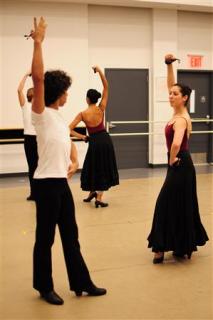Flamenco! Work out with a passion
(Agencies)
Updated: 2010-09-21 09:20
 |
Large Medium Small |

For people who take Flamenco classes, it's not just about developing the body of a speed skater, it's about channeling the soul of a Spanish dancer.
"Flamenco is a great cardio vascular workout because it's nonstop," said Cal Pozo, a dancer, choreographer and fitness expert. "It was probably Spain's step aerobics of its time."
But above all, he added, flamenco dance is about self-expression.
Pozo, who produces DVDs for the television shows such as Dancing with the Stars and Biggest Loser, said the flamenco workout resembles speed skating.
"You're constantly in a knee-flex position. Flamenco dancers have the most incredible legs, butts and thighs of any dancer."
In some cultures young girls take flamenco lessons as commonly as they do ballet lessons in the United States, according to Pozo, whose first dance lessons were flamenco, courtesy of his Spanish-born parents.
Jackie Kalata, a flamenco teacher at Ballet Hispanico School of Dance in New York City, instructs adults as well as children.
"It's usually a person who doesn't just want to do an aerobics class," she says of the adults who attend her group classes, adding that they are attracted by the culture.
"I have students do a whole warm-up, including shoulders, torso, legs, squats," she said. "Some movements are foreign to the non-Spanish culture so I use exercises to break it down. It's gradual because its complex."
Kalata said with regular practice the adult chest opens up and the back, the legs become very toned, "and the arm work really trains the triceps."
If the moves are initially alien, the passions are universal, according to Kalata.
"With most people it kicks in right from the first lesson. "Everybody feels loneliness, sorrow, happiness."
Flamenco music and dance is thought to have originated in 15th century Andalusia when Spain was under Arab domination. Gypsies, Christians, Moors, and Jews, are among the many groups who've shaped modern flamenco.
Kalata says flamenco shoes, which have nails hammered into their heels and toes, are thought to derive from the tap shoes of touring 19th century American dancers.
Flamenco has become such a hybrid that even flamenco historians, called flamencologists, disagree about the origins of the word.
Sara Erde has been a flamenco dancer since her parents took her to Ballet Hispanico when she was six years old.
"That's what I loved since I was a little kid," said Erde, who is an assistant choreographer for the Metropolitan Opera's production of Carmen.
As an adult she had moved to Spain.
"Dance there is much more integrated into life there. Here people go to a dance class. There housewives dance in their kitchens."
Erde believes flamenco holds a potent appeal for women.
"You stand up straight and tall and proud and you make noise. There's this sense of empowerment. It's sort of a defiant 'this is who I am.'"
She is currently developing a flamenco class for business women to enable them to feel a sense of empowerment and strength, while at the same time feeling sexy and sensual.
"When you're dancing you don't feel like you're exercising," said Erde. "Your spirit feels good. You're allowed to express anger. You're allowed to express every emotion."